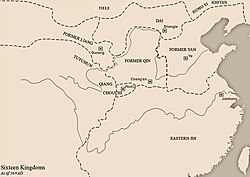Dai 代 | |||||||||
|---|---|---|---|---|---|---|---|---|---|
| 310–376 | |||||||||
 China in 369 CE. Dai is visible at the top of the map. | |||||||||
| Status | Vassal of Jin Dynasty, Later Zhao, Former Yan, Former Qin | ||||||||
| Capital | Shengle (310–324, 337–338, 340–376) Mount Dongmugen (324–327) Daning (327–337) Fanji (338–340) | ||||||||
| Government | Monarchy | ||||||||
| Prince | |||||||||
• 310–316 | Tuoba Yilu | ||||||||
• 338–376 | Tuoba Shiyijian | ||||||||
| History | |||||||||
• Established | 310 | ||||||||
• Status upgraded from dukedom to principality | 315 | ||||||||
• Disestablished | 376 | ||||||||
| |||||||||
| Today part of | China Mongolia | ||||||||
| Dai | |||||||||
|---|---|---|---|---|---|---|---|---|---|
| Traditional Chinese | 代國 | ||||||||
| Simplified Chinese | 代国 | ||||||||
| Literal meaning | State of Dai | ||||||||
| |||||||||
Dai, also rendered as Tai and sometimes known in historiography as the Tuoba Dai (Chinese: 拓跋代), was a dynastic state of China ruled by the Tuoba clan of Xianbei descent, during the era of Sixteen Kingdoms (although it is not listed as one of the 16). It existed from AD 310 to 376,[1] with its capital at Shengle (near modern Horinger County of Hohhot, Inner Mongolia, China).
The name "Dai" originated when Tuoba Yilu was appointed the Duke of Dai (代公) by the Western Jin dynasty in 310, as a reward for helping Liu Kun, the Governor of Bingzhou (并州), fight against the Xiongnu-led Han-Zhao dynasty. The fief was later promoted from a duchy to a principality in 315. Dai was conquered in 376 by the Former Qin dynasty, and its descendants later established the Northern Wei dynasty in 386.
- ^ Grousset, Rene (1970). The Empire of the Steppes. Rutgers University Press. pp. 57. ISBN 0-8135-1304-9.